This lemon lavender cake (or loaf) has plenty of freshly grated lemon zest and a little hum of herbaceous, florally lavender. Topped with a simple icing sugar glaze, it’s such a treat with your favourite cuppa!
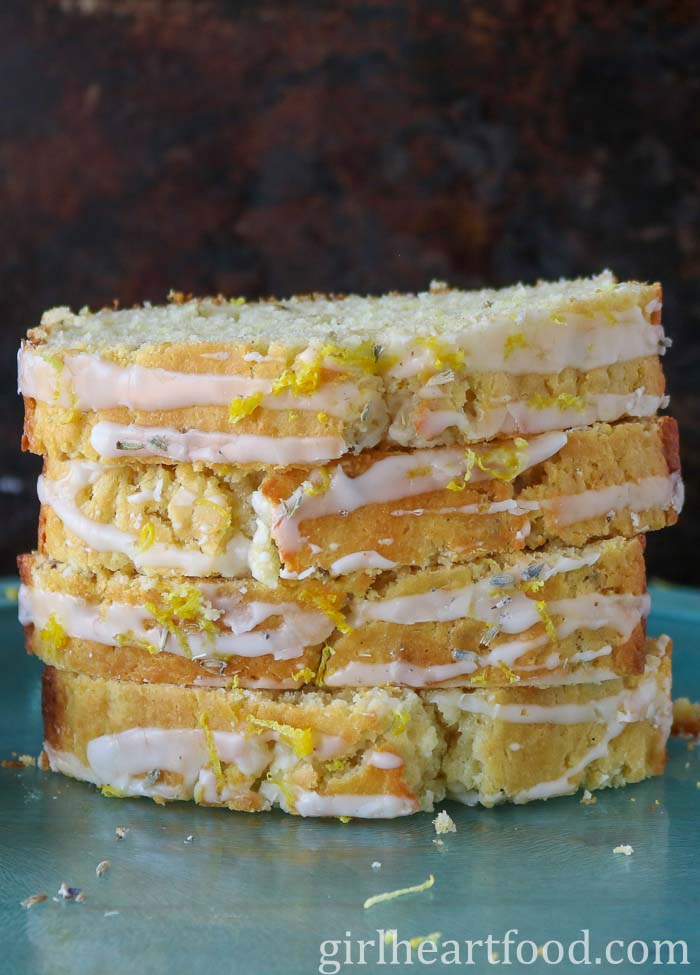
Hi friends!
Super happy to be sharing this lavender recipe with you guys today!
This lemon lavender cake is easy to prepare, not at all too sweet and such a great accompaniment to your afternoon cuppa tea or coffee.
Since it’s Mother’s Day, this would be a perfect homemade treat to make (and maybe a loaf just for you too?).
To make things extra special, give a slice (or two) a generous spread of homemade lemon curd. Talk about yummy!
Enjoy loaf cakes? Check out this blueberry banana bread!
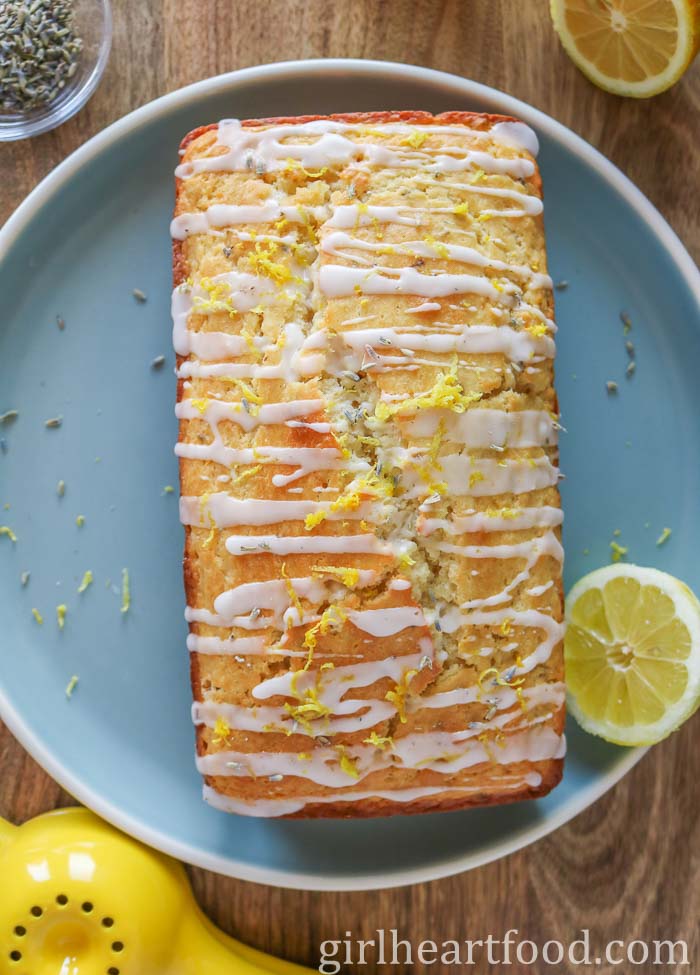
What Does Dried Lavender Taste Like?
Lavender, believe it or not, is actually part of the mint family (as is basil, thyme and rosemary).
It definitely has floral notes and is slightly herbaceous. To me, though, I don’t notice any mint qualities.
Cooking with lavender can be quite fun because of its versatility. Dried lavender can be used in both savoury and sweet recipes (like this one), and even infused into simple syrups for mocktails and cocktails.
Lavender is a common component in Herbes de Provence (a herb mix blend that I use quite often).
Lavender pairs well with other strong flavours, like the lemon zest that’s used in this loaf.
Because of its potency, when using lavender it’s better to go on the side of “less is more.” Too much, and it’ll be too floral. A little will give you a nice background hum.
Note: Make sure you buy and use “culinary lavender,” that is, lavender meant for consumption.
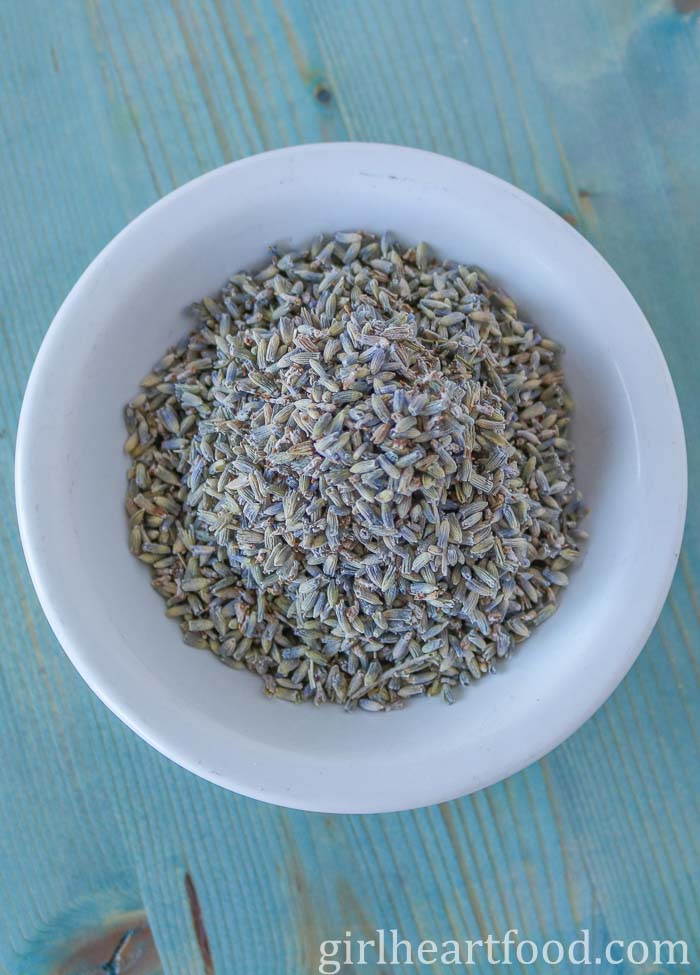
Can I Freeze This Loaf?
Absolutely!
It’s better to freeze an unglazed cake (as the glaze doesn’t look as pretty after freezing and thawing). However, you can still freeze the cake if it’s glazed. No biggie, just something to keep in mind.
Wrap the cooled cake in plastic food wrap, then wrap in aluminum foil (or just two layers of plastic food wrap). Place into a freezer-safe container. Don’t forget to label with the recipe name and date it was made.
When ready to enjoy, remove the cake from the container (but still leave wrapped) and let thaw at room temperature.
The cake can be frozen for up to 3 months.
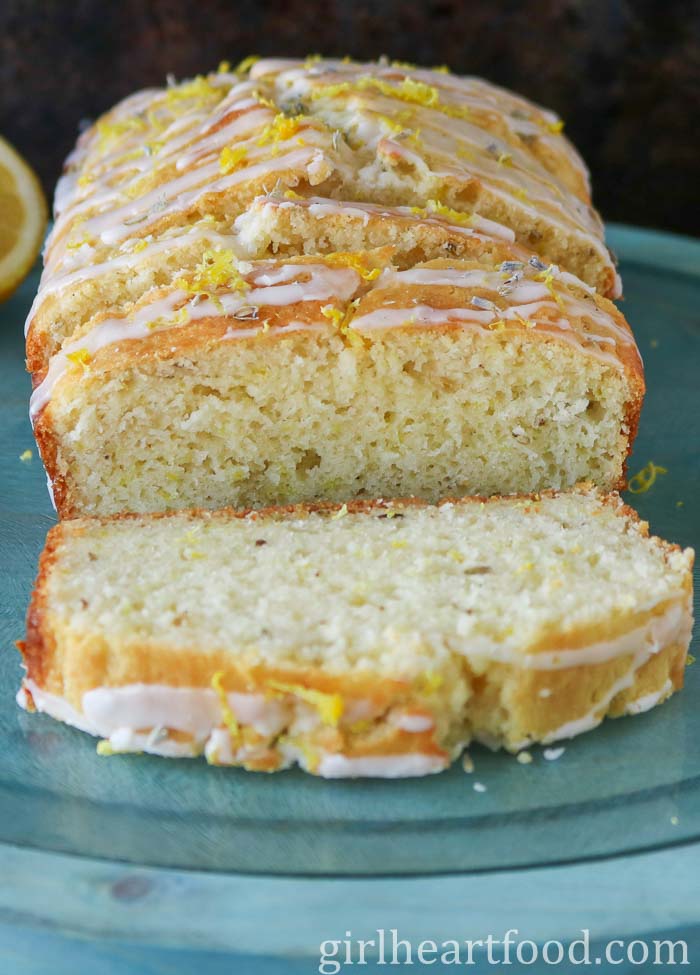
Tips for Making This Recipe
- Want more of a lavender hum? Add a little more. Alternatively, you can grind more of your dried lavender into a powder-ish form with a mortar and pestle rather than leaving whole. It will permeate more throughout the loaf.
- This loaf cake has a lovely lemon flavour. For even more, you can certainly add more lemon zest or mix in a teaspoon or so of lemon extract.
- Icing sugar glaze is totally optional here. Alternatively, you can dust with a little icing sugar.
- Do not glaze your loaf until it has completely cooled. Otherwise, the glaze will soak right into the loaf.
- When making the glaze, always start with a little liquid first before adding more. You want a thick consistency. If it’s too thin, add a little more icing sugar. If it’s too thick, add a little more water.
- For ease, line your greased loaf pan with some parchment paper and grease again before adding your cake batter (as below). The loaf lifts easily out of the pan after it has baked.
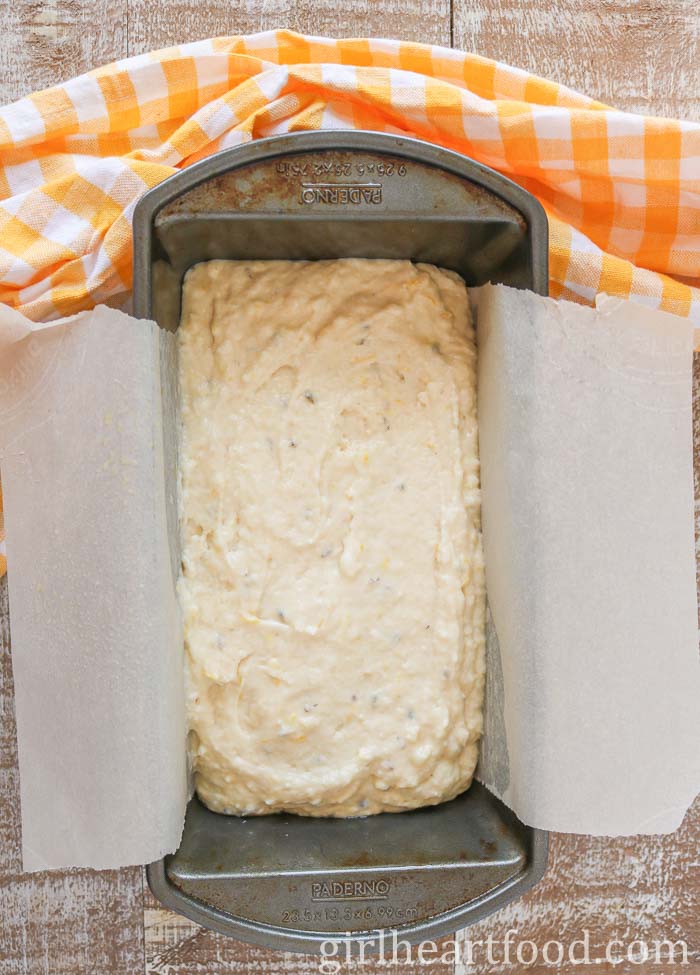
If you make this lemon lavender cake, be sure to leave a comment below!
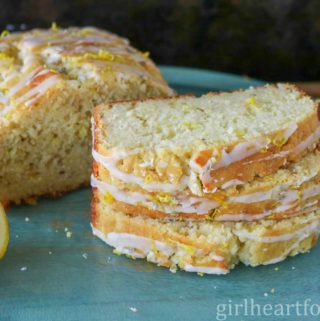
Lemon Lavender Cake
Ingredients
Lemon Lavender Cake
- Baking spray, to grease pan (or use butter)
- 2 cups all-purpose flour, spooned into measuring cup and leveled off with a butter knife
- 3 tablespoons grated lemon zest, from about 2 to 3 lemons (plus more to taste for optional garnish)
- 1 tablespoon baking powder
- 3 teaspoons dried culinary lavender, divided (plus more to taste for optional garnish)
- ½ teaspoon salt
- ½ cup unsalted butter, softened (1 stick)
- ⅔ cup granulated sugar
- 2 large eggs
- 1 teaspoon vanilla extract
- 1 cup milk
Icing Sugar Glaze
- ½ cup icing sugar
- 1 to 1.5 tablespoons lemon juice, depending on the consistency you want
Instructions
Lemon Lavender Cake
- Preheat oven to 350 degrees Fahrenheit.
- Spray a 9-inch x 5-inch loaf pan with baking spray or grease with butter, then line with some parchment paper (the parchment paper should cover the bottom and two longest sides of the loaf pan, with some parchment paper slightly overhanging the longest sides — this makes for easy removal of the lemon lavender cake after it's baked). Then spray the parchment paper with baking spray or grease with butter. Set aside.
- In a bowl, whisk together the flour, lemon zest, baking powder, dried culinary lavender (grind or chop 1.5 teaspoons of the lavender to a powder, while leaving the remaining 1.5 teaspoons whole) and salt. Set aside.
- In the bowl of a stand mixer fitted with a paddle attachment (or using a mixing bowl and hand mixer), blend (on medium-high speed) butter and sugar until smooth, combined and fluffy, about 2 to 3 minutes (stop as necessary to scrape the sides of the bowl with a rubber spatula).
- Reduce speed and add eggs, one at a time, blending after each addition. Don't overmix.
- Add vanilla extract and blend.
- Alternate between milk and reserved flour mixture; blend until there are no streaks of flour remaining. Don't overmix.
- Pour batter into the prepared pan.
- Bake for 45 to 55 minutes or until a wooden skewer or cake tester inserted in the centre of the cake comes out clean. Allow the cake to cool for 10 minutes in the pan. Then remove the cake from the pan and allow to fully cool on a cooling rack before glazing.
Icing Sugar Glaze
- Combine icing sugar and lemon juice in a bowl and whisk until smooth. It's best to start with 1 tablespoon of juice and add more, if needed.Tip: The more lemon juice you add, the thinner the glaze will be. If you thin the glaze too much, you can add a little more icing sugar to thicken.
Glaze the Cake
- Once the cake is cool, drizzle over icing sugar glaze. Sprinkle over some more lemon zest and lavender (if desired). Slice and enjoy!
Notes
- Want more of a lavender hum? Add a little more. Alternatively, you can grind more of your dried lavender into a powder-ish form with a mortar and pestle rather than leaving whole. It will permeate more throughout the loaf.
- This loaf cake has a lovely lemon flavour. For even more, you can certainly add more lemon zest or mix in a teaspoon or so of lemon extract.
- Icing sugar glaze is totally optional here. Alternatively, you can dust with a little icing sugar.
- Speaking of icing sugar glaze, do not glaze your loaf until it has completely cooled. Otherwise, the glaze will soak right into the loaf.
- When making the glaze, always start with a little liquid first before adding more. You want a thick consistency. If it’s too thin, add a little more icing sugar. If it’s too thick, add a little more water.
- For ease, line your loaf pan with some parchment paper and grease before adding your cake batter. The loaf lifts easily out of the pan after it has baked.
A note on times provided: appliances vary, any prep and/or cook times provided are estimates only.
© Girl Heart Food Inc. Photographs and content are copyright protected.
Tried this recipe?
If you do make this recipe, thank you!! It would mean so much if you could leave a comment below. Love to know how you enjoyed it, and it helps other readers too!


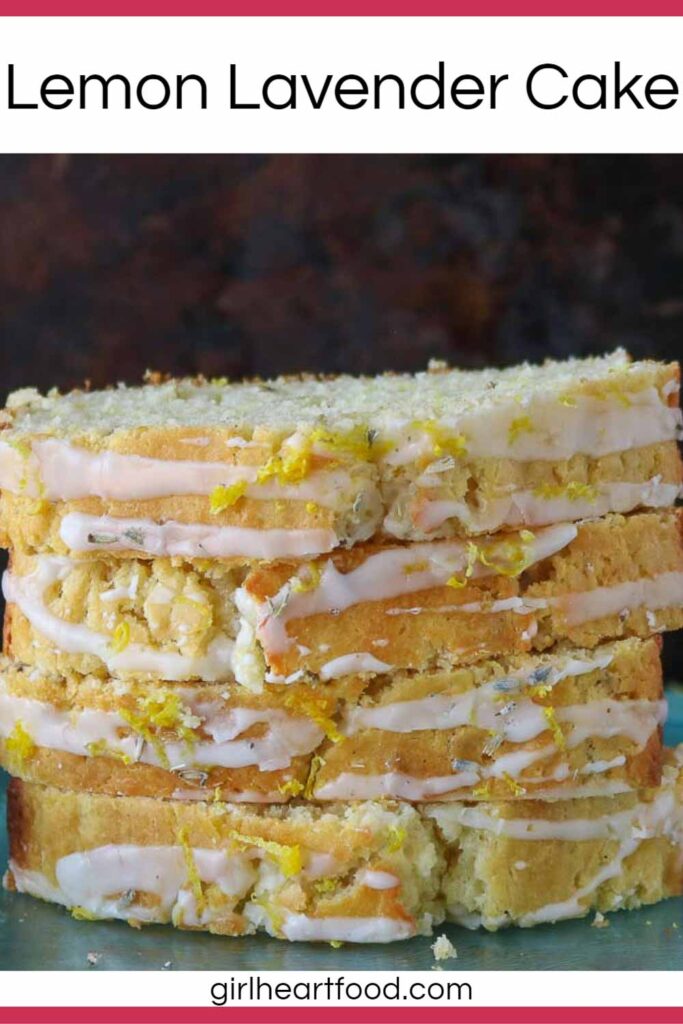
Valentina
What a beautiful cake. Lavender is such a lovely herb and so fun to cook with — especially with lemon, and in desserts. I love it! 🙂 ~Valentina
Dawn - Girl Heart Food
It really is! Thanks so much.
Marissa
This cake has the perfect texture, Dawn! And I love the combination of zesty lemon and floral lavender! Totally drool worthy.
Dawn - Girl Heart Food
Thank you very much, Marissa!
Kathy @ Beyond the Chicken Coop
Okay – can you believe I’ve never cooked with lavender before? It’s true! I need to give that a change and start baking with it. I grow lot of lavender so I have a good supply of it. This cake looks like a good place to start!
Dawn - Girl Heart Food
Lucky you! Thank you, Kathy.
Katherine | Love In My Oven
This is such a beautiful, fancy loaf, Dawn!! So lovely for Mother’s Day (or any day). I have yet to bake anything with lavender myself. I wish I could have had a few slices yesterday with my tea 🙂 Hope you had a terrific weekend, my friend.
Dawn - Girl Heart Food
Thank you, Katherine! Hope your week is going great!
annie@ciaochowbambina
“…has plenty of freshly grated lemon zest and a little hum of herbaceous, floral-ly lavender.” I love this description. This will be the perfect addition to my afternoon tea. So tender and tasty! Happy week, my friend! xoxo
Dawn - Girl Heart Food
Aww, you’re so kind! Thank you, Annie! XOXO
Jennifer @ Seasons and Suppers
Lemon and lavender is such a lovely combination and even better when combined in a lovely lemon loaf 🙂 Looks delicious!
Dawn - Girl Heart Food
Thank you, Jennifer!
Mary Ann | The Beach House Kitchen
I totally love this flavor combination Dawn. so refreshing. Can’t wait to bake a loaf!
Dawn - Girl Heart Food
Thank you, Mary Ann! Enjoy!
David @ Spiced
Every time I see lavender, I think of Ben @ Havoc in the Kitchen. haha! I do agree with lemon + lavender is a great combination…and in this cake? Sounds perfect with a mid-morning cup of tea! And you’re totally right about lavender. Start with a little and go from there. That flavor can build quickly! Oh, and lavender is part of the mint family!? Interesting! I guess it kinda makes sense, but count that as something new I learned today.
Dawn - Girl Heart Food
Always nice to learn something new, right? Thank you, David!
Alex
How beautiful, Dawn! I love lemon cakes, and I think the lavender would work so lovely in this. I am so excited to give it a try!
Dawn - Girl Heart Food
Yay! Thank you, Alex. Enjoy!
Kelsie| the itsy-bitsy kitchen
This is just such a pretty treat! Lemon and lavender are just delicious together and I’m definitely craving a slice of this right now! (And I’m pre-craving it with my coffee tomorrow morning too.) Have a great week, Dawn!
Dawn - Girl Heart Food
Thank you, Kelsie! Hope you have a great weekend ahead!
Paula
Hi Dawn – Can you tell me where I can find Lavender in St. John’s. I have never seen it in the grocery stores.
Dawn - Girl Heart Food
Hi Paula – I’ve had luck at Winner’s. You can usually order online at Amazon too. 🙂 Have a great day!